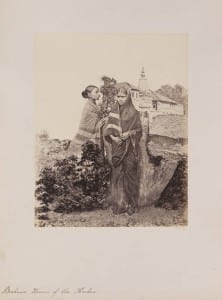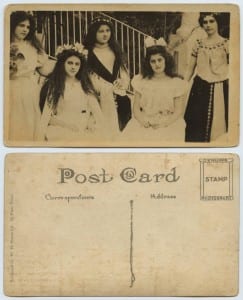Title: Five teenage girls in front of stairs (1910-1920)
Photographer: Walter H. Horne
This post card features five teenage girls poised for a photograph in front of white stairs in Mexico. The girls are dressed in very expensive clothing and headpieces. They are adorned with fine jewels such as large strings of pearls around their necks as well as gold cross necklaces. Two of the girls wear more native dress with beads and embellishments not of European origin. Their hair is all worn down in their natural curls suggesting that they are not yet of age where it is considered improper to have hair worn down.
These girls are clearly a part of the Mexican elite. They have very fair skin suggesting they most likely have Spanish blood versus native or black. Additionally, the gold cross necklaces suggest that they are Christian women. Their clothes, jewelry and religion make me conclude that they affiliate with Europeans instead of the native population. At this time there was an extreme divide between the Mexican elite and the majority of Mexico. The elite affiliated with their Spanish blood and believed that native, and especially black blood, made their lineage impure. The socioeconomic status of women was derived almost entirely by their ancestry.
Title: Brahmin Women of the Konkan (1855-1862)
Photographer: William Johnson
These two women pictured are a part of the Brahmin caste in India. The Brahmin caste is the highest of the four castes. These women hold themselves in an almost regal manner; different from the slumping, nervous posture of other Indian women I have seen in photographs. They are adorned in fine jewels, with elaborate updos. Although it is difficult to see any color or detail on their saris, it can be assumed that they are made of fine cloth. These women are married because underneath their saris one can glimpse that they are wearing necklaces. This necklace is the mangalsutra, a gold and black bead necklace that is the marriage symbol for Brahmin women. They do not stare into the lense of the camera out of respect. Although they belong to the highest caste in India, women are always secondary to men in this society.



